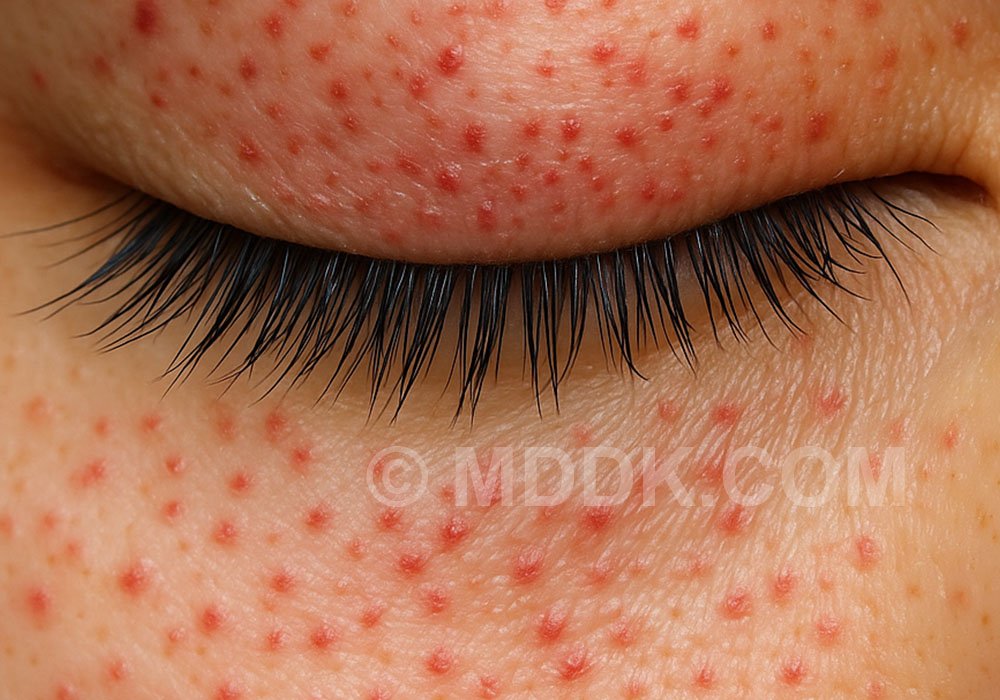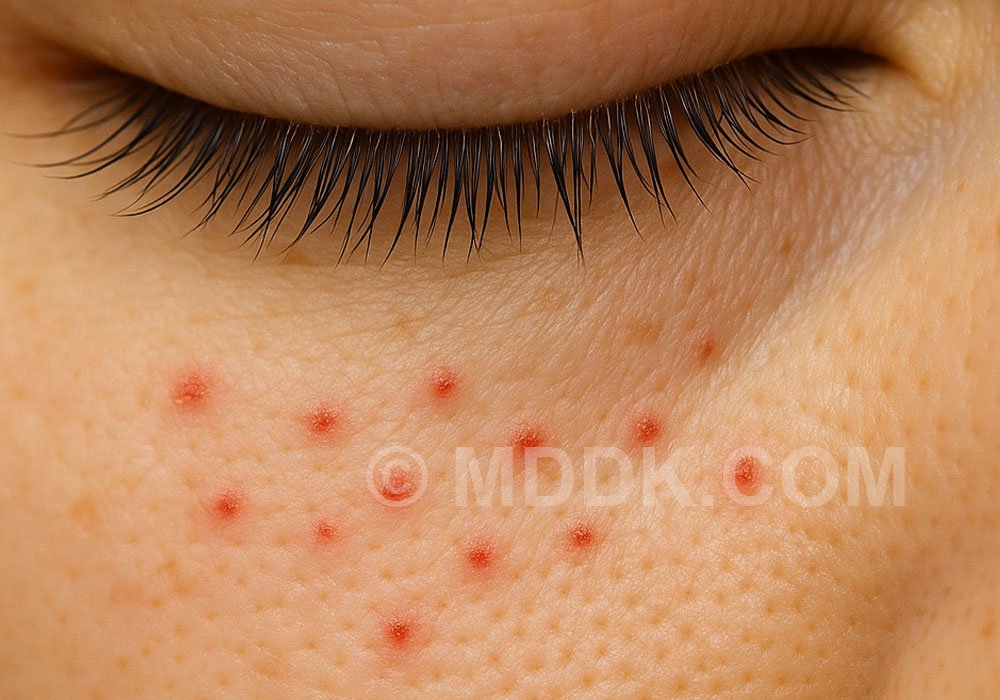Red dots under the eye
Red dots under the eye are small, pinpoint spots that can appear on the skin just below the lower eyelid. They may be flat or slightly raised and can range in color from bright red to purplish-red. In many cases, these spots are known as petechiae, which occur when tiny blood vessels called capillaries break and leak small amounts of blood under the skin. While they are often harmless and temporary, they can also be a sign of an underlying medical condition that requires attention.
The skin under the eyes is delicate and thin, making blood vessels in this area more prone to damage. This is why red dots can be more visible here compared to other parts of the face. Understanding the potential causes can help determine whether the condition is minor and self-resolving or if medical advice is needed.

Causes of Red dots under the eye
1. Dermatological Causes
- Allergic reactions: Allergens such as cosmetics, skincare products, or pollen can trigger inflammation and redness in the under-eye area.
- Contact dermatitis: Irritation from makeup, soaps, or facial cleansers can cause localized redness and small spots.
- Eczema or atopic dermatitis: Chronic skin conditions may lead to persistent redness, itching, and small bumps under the eyes.
2. Vascular Causes
- Petechiae from broken capillaries: Increased pressure in the blood vessels from activities like coughing, sneezing, or vomiting can cause small capillaries to break, resulting in tiny red spots.
- Microvascular bleeding: Conditions affecting small blood vessels can cause spontaneous bleeding under the skin.
3. Infectious Causes
- Viral infections: Illnesses such as measles or rubella may cause widespread rash that can appear under the eyes.
- Bacterial skin infections: Infections like impetigo may start with red spots and progress to other skin changes.
4. Trauma or Physical Strain
- Rubbing the eyes too hard can cause local irritation and damage small capillaries.
- Physical strain from intense exercise or heavy lifting can increase blood vessel pressure and cause red dots.
5. Systemic Causes
- Blood clotting disorders: Low platelet counts or clotting problems can lead to petechiae in various parts of the body, including under the eyes.
- Vasculitis: Inflammation of blood vessels can cause redness and spots.
- Side effects of medications: Drugs such as anticoagulants or steroids can increase the likelihood of bleeding under the skin.
Symptoms and Associated Signs
1. Appearance
- Size may range from tiny pinpoints to slightly larger spots.
- Color can vary from bright red to reddish-purple.
- Spots may be flat or slightly raised.
2. Localized Symptoms
- Itching: Common in allergic reactions or eczema.
- Mild swelling: Often seen in skin irritation or allergic conditions.
- Tenderness or pain: May occur if the area is inflamed or infected.
- Dryness or flaking skin: Frequently seen with eczema or dermatitis.
3. General Symptoms (Associated with Underlying Conditions)
- Fever: May suggest an infection such as measles, rubella, or bacterial skin infection.
- Fatigue or weakness: Could indicate a systemic illness affecting blood vessels or clotting.
- Easy bruising or bleeding in other areas: May be a sign of a clotting disorder or low platelet count.
- Widespread rash: Suggests a viral infection, allergic reaction, or autoimmune condition.
4. Duration and Progression
- Spots from minor trauma or rubbing usually fade within a few days.
- Spots from systemic conditions may persist or worsen over time if the cause is not treated.
Risk Factors
Certain factors can increase the likelihood of developing red dots under the eyes. People with sensitive or thin skin in the under-eye area are generally more prone to these spots, as the delicate capillaries can break more easily. Individuals who frequently rub their eyes due to allergies or irritation also have a higher risk, since repeated friction can damage small blood vessels.
Age can play a role as well. As skin becomes thinner and blood vessels more fragile with age, even minor trauma or pressure can cause visible spots. People with chronic skin conditions such as eczema or rosacea may also notice recurrent redness in this area.
Underlying medical conditions, including blood clotting disorders or platelet abnormalities, significantly increase the risk. These conditions make capillaries more susceptible to bleeding even with minimal strain. Additionally, certain medications such as blood thinners, corticosteroids, or chemotherapy drugs can reduce the body’s ability to stop bleeding, which may lead to petechiae.
Lifestyle habits are another consideration. Smoking, poor diet, and excessive alcohol intake can weaken blood vessels over time, making the skin more vulnerable. Strenuous activities like heavy weightlifting, frequent coughing, or severe vomiting can temporarily increase pressure in facial blood vessels, causing red dots to appear.
- Thin or sensitive skin around the eyes
- Chronic eye rubbing or facial friction
- Advancing age and fragile capillaries
- Underlying clotting disorders or low platelet count
- Use of blood-thinning or steroid medications

Diagnosis
Diagnosis usually begins with a detailed medical history and a physical examination. A doctor will first assess the appearance of the red dots, noting their size, distribution, and whether they are limited to the under-eye area or appear elsewhere on the body. The presence of other symptoms such as swelling, pain, fever, or easy bruising can help guide the next steps.
In many cases, the cause can be determined from the patient’s history alone, such as recent eye rubbing, episodes of coughing or vomiting, or use of certain medications. If there is concern about an underlying condition, the doctor may order specific tests.
Common investigations include blood tests to check platelet count, clotting factors, and signs of infection or inflammation. If a skin condition is suspected, a dermatologist may perform a dermatoscopic examination or recommend a skin biopsy to rule out other disorders. For suspected systemic illnesses, additional imaging or specialist referrals may be necessary.
Early diagnosis is important, particularly if the red dots are persistent, spreading, or accompanied by other warning signs such as unexplained bleeding or prolonged fever.
- Visual examination of the skin and surrounding area
- Review of recent activities, illnesses, and medications
- Blood tests to check platelets and clotting function
- Dermatological assessment for skin disorders
Treatment Options for Red Dots Under the Eye
Treatment depends on the underlying cause of the red dots. If they result from minor trauma, such as rubbing the eyes or physical strain, they often resolve on their own within a few days without the need for medical intervention. Applying a cold compress can help reduce swelling or irritation in the area, but care should be taken not to press too hard.
For red dots caused by allergic reactions or skin irritation, removing the trigger is essential. Switching to hypoallergenic cosmetics or skincare products, avoiding harsh cleansers, and protecting the skin from further irritation can speed recovery. In some cases, a mild topical steroid or antihistamine cream may be prescribed to relieve itching and redness.
If an infection is responsible, treatment may involve antiviral or antibiotic medications depending on the type of infection. Bacterial skin infections like impetigo often require topical or oral antibiotics, while viral rashes may be managed with supportive care until the infection resolves.
When red dots are linked to systemic conditions such as clotting disorders, treatment focuses on addressing the underlying health problem. This may involve adjusting medications, prescribing platelet-boosting therapies, or managing chronic illnesses that affect blood vessels.
Lifestyle changes can also play a role in prevention and recovery. Maintaining a healthy diet, staying hydrated, avoiding excessive alcohol, and quitting smoking can strengthen blood vessels and improve skin health.
- Cold compress for minor trauma or irritation
- Topical creams for allergic or inflammatory skin conditions
- Antibiotics or antivirals for infections
- Medical management of underlying systemic disorders
Frequently Asked Questions
Are red dots under the eye dangerous?
In most cases, red dots under the eyes are not dangerous and are caused by minor issues such as rubbing the eyes, sneezing, or a temporary increase in blood pressure that breaks small capillaries. However, they can sometimes indicate an underlying health condition like a blood clotting disorder, vasculitis, or an infection. If they appear suddenly without a clear cause, are persistent, or are accompanied by symptoms like fever, fatigue, or unexplained bruising, it is important to seek medical attention.
How long do red dots under the eye take to go away?
The duration depends on the cause. Red dots from minor trauma or rubbing usually fade within a few days as the broken capillaries heal naturally. Those caused by allergic reactions may disappear within a week if the allergen is removed and treatment is given. If the cause is related to an underlying medical condition, they may persist until that condition is managed.
Can allergies cause red dots under the eyes?
Yes. Allergic reactions can cause inflammation, swelling, and increased fragility of small blood vessels in the skin, which may result in red spots. Common allergens include pollen, pet dander, cosmetics, skincare products, and certain foods. Managing allergies with antihistamines and avoiding known triggers can reduce the risk of developing red dots.
Do I need to see a doctor for red dots under my eyes?
Not always. If the dots are clearly linked to a minor cause like rubbing your eyes or recent physical strain, they will likely heal on their own. However, medical evaluation is recommended if:
- The dots appear suddenly without an obvious reason
- They are spreading or worsening
- They are accompanied by symptoms like fever, fatigue, or bleeding elsewhere
- You have a known blood clotting problem or low platelet count
Can makeup cause red dots under the eyes?
Yes. Makeup products, especially those containing fragrances or harsh chemicals, can cause allergic reactions or irritation in the delicate under-eye skin. Prolonged use of expired or contaminated makeup can also lead to inflammation and skin damage. Using hypoallergenic and fragrance-free products, along with proper makeup removal, can help prevent such reactions.
Will cold compresses help?
Yes. A gentle cold compress can help reduce swelling, irritation, and discomfort. Wrap a clean cloth around an ice pack and apply it for 5 to 10 minutes. Avoid pressing too hard, as this can further damage fragile blood vessels.
Can dehydration or poor diet cause red dots under the eyes?
Indirectly, yes. Poor hydration and an unbalanced diet can weaken skin and blood vessel health over time, making capillaries more prone to breaking. Nutrient deficiencies, particularly in vitamin C and vitamin K, can impair blood vessel integrity and clotting function.
Do red dots under the eyes happen with COVID-19 or other viral infections?
Some viral infections, including COVID-19, measles, and other viral rashes, can cause small red spots on the skin. These may appear anywhere on the body, including under the eyes. In such cases, the red dots are often accompanied by fever, fatigue, and other systemic symptoms.
Can stress or lack of sleep cause red dots under the eyes?
Stress and poor sleep do not directly cause red dots, but they can make the skin and blood vessels more fragile. Stress may also worsen underlying skin conditions like eczema or rosacea, indirectly increasing the likelihood of red spots.
Can exercise cause red dots under the eyes?
Yes. Intense exercise, heavy lifting, or straining can temporarily increase blood pressure and cause small capillaries in the face to break, leading to petechiae under the eyes. These usually resolve on their own within a few days.